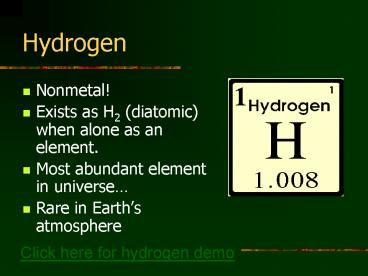Hydrogen - PowerPoint PPT Presentation
1 / 17
Title: Hydrogen
1
Hydrogen
- Nonmetal!
- Exists as H2 (diatomic) when alone as an element.
- Most abundant element in universe
- Rare in Earths atmosphere
Click here for hydrogen demo
2
Alkali Metals
- Group 1 (1A)
- Properties of all metals
- Shiny Good Conductors
- Malleable can be hammered into thin sheets.
- Ductile can be drawn into thin wires.
http//wps.prenhall.com/wps/media/objects/602/616
516/Media_Assets/Chapter01/Text_Images/FG01_02-04U
N.JPG
3
Alkali Metals
- Low density and melting points.
- Soft and silver-white in color
- Highly unstable elements that are not found pure
in nature.
http//www.microchem.de/elec000a-k.JPG
4
Alkali Metals
- All form 1 ions.
- Most reactive metals on table (low ionization
energy) and this increases from Li to Fr.
Click here for Alkali Metals Water Demos
http//wps.prenhall.com/wps/media/objects/476/488
316/Instructor_Resources/Chapter_09/FG09_33.JPG
5
Alkaline Earth Metals
- Group 2A
- Higher density and M.P. than Alkali Metals.
http//wps.prenhall.com/wps/media/objects/602/616
516/Media_Assets/Chapter01/Text_Images/FG01_02-04U
N.JPG
6
Alkaline Earth vs. Alkali Metals
http//wps.prenhall.com/wps/media/objects/602/616
516/Media_Assets/Chapter06/Text_Images/FG06_TB05.J
PG
7
Alkaline Earth Metals
- More of a silver-metallic color for this group.
- Also highly reactive in nature, but can be stored
as an element.
http//www.chemsoc.org/viselements/pages/data/gra
phic/ca_data.jpg
8
Alkaline Earth Metals
- All form 2 ions.
Click here for videos on the Alkaline Earth Metals
http//wps.prenhall.com/wps/media/objects/476/488
316/Instructor_Resources/Chapter_09/FG09_34.JPG
9
p-Block Groups
- Groups 13-16 named after the first element.
- Boron Group 13 (3A)
- 3 ions
10
http//wps.prenhall.com/wps/media/objects/602/616
516/Media_Assets/Chapter19/Text_Images/FG19_TB03.J
PG
11
p-Block Groups
- Carbon Group 14 (4A)
- No ion pattern because all have 4 valence
electrons
http//wps.prenhall.com/wps/media/objects/602/616
516/Media_Assets/Chapter19/Text_Images/FG19_02-09U
N.JPG
12
p-Block Groups
Nitrogen Group (-3 ions)
Oxygen Group (-2 ions)
http//wps.prenhall.com/wps/media/objects/602/616
516/Media_Assets/Chapter19/Text_Images/FG19_02-09U
N.JPG
13
p-Block Groups
- Both Nitrogen and Oxygen are diatomic as elements
(N2 O2)
14
Halogens
- Group 17 (7A)
- Some are diatomic when alone as an element.
http//wps.prenhall.com/wps/media/objects/602/616
516/Media_Assets/Chapter01/Text_Images/FG01_02-04U
N.JPG
15
The Super Seven are all diatomic when alone as
elements!
16
Halogens
- Exist as gas, liquids, and solids with distinct
colors.
17
Halogens
- Most reactive non-metals on table and increases
from I To F. - All form 1 ions.
- Most form salts by combining with alkali metals.
(1 ion with 1 ion)
Click here for Halogen reactivity video
Click here for videos on the Halogens































